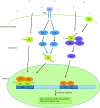Are Estrogen Receptor Genomic Aberrations Predictive of Hormone Therapy Response in Breast Cancer?
- PMID: 27761212
- PMCID: PMC5056018
- DOI: 10.17795/ijcp-6565
Are Estrogen Receptor Genomic Aberrations Predictive of Hormone Therapy Response in Breast Cancer?
Abstract
Context: Breast cancer is the most common cancer in women worldwide. Estrogen receptor (ER) positive breast cancer constitutes the majority of these cancers. Hormone therapy has significantly improved clinical outcomes for early- and late-stage hormone receptor positive breast cancer. Although most patients with early stage breast cancer are treated with curative intent, approximately 20% - 30% of patients eventually experience a recurrence. During the last two decades, there have been tremendous efforts to understand the biological mechanisms of hormone therapy resistance, with the ultimate goal of implementing new therapeutic strategies to improve the current treatments for ER positive breast cancer. Several mechanisms of hormone therapy resistance have been proposed, including genetic alterations that lead to altered ER expression or ERs with changed protein sequence.
Evidence acquisition: A Pubmed search was performed utilizing various related terms. Articles over the past 20 years were analyzed and selected for review.
Results: On the basis of published studies, the frequencies of ESR1 (the gene encoding ER) mutations in ER positive metastatic breast cancer range from 11% to 55%. Future larger prospective studies with standardized mutation detection methods may be necessary to determine the true incidence of ESR1 mutations. ESR1 amplification in breast cancer remains a controversial issue, with numerous studies either confirmed or challenged the reports of ESR1 amplification. The combination of intra-tumor heterogeneity regarding ESR1 copy number alterations and low level ESR1 copy number increase may account for these discrepancies.
Conclusions: While numerous unknown issues on the role of ESR1 mutations in advanced breast cancer remain, these new findings will certainly deepen current knowledge on molecular evolution of breast cancer and acquired resistance to hormone therapy.
Keywords: Breast Cancer; ESR1 Amplification; ESR1 Mutation; Estrogen Receptor; Hormone Therapy.
Conflict of interest statement
Conflict of Interests:The authors declare none.
Figures


Similar articles
-
Overview of resistance to systemic therapy in patients with breast cancer.Adv Exp Med Biol. 2007;608:1-22. doi: 10.1007/978-0-387-74039-3_1. Adv Exp Med Biol. 2007. PMID: 17993229 Review.
-
ESR1 alterations and metastasis in estrogen receptor positive breast cancer.J Cancer Metastasis Treat. 2019;5:38. doi: 10.20517/2394-4722.2019.12. Epub 2019 May 4. J Cancer Metastasis Treat. 2019. PMID: 31106278 Free PMC article.
-
Estrogen-Receptor Loss and ESR1 Mutation in Estrogen-Receptor-Positive Metastatic Breast Cancer and the Effect on Overall Survival.Cancers (Basel). 2024 Aug 30;16(17):3025. doi: 10.3390/cancers16173025. Cancers (Basel). 2024. PMID: 39272884 Free PMC article.
-
ESR1 fusions and therapeutic resistance in metastatic breast cancer.Front Oncol. 2023 Jan 4;12:1037531. doi: 10.3389/fonc.2022.1037531. eCollection 2022. Front Oncol. 2023. PMID: 36686845 Free PMC article. Review.
-
Clinical Implications of ESR1 Mutations in Hormone Receptor-Positive Advanced Breast Cancer.Front Oncol. 2017 Mar 15;7:26. doi: 10.3389/fonc.2017.00026. eCollection 2017. Front Oncol. 2017. PMID: 28361033 Free PMC article. Review.
Cited by
-
Validation of liquid biopsy for ESR1-mutation analysis in hormone-sensitive breast cancer: a pooled meta-analysis.Front Oncol. 2023 Aug 22;13:1221773. doi: 10.3389/fonc.2023.1221773. eCollection 2023. Front Oncol. 2023. PMID: 37675216 Free PMC article. Review.
-
Currently Applied Molecular Assays for Identifying ESR1 Mutations in Patients with Advanced Breast Cancer.Int J Mol Sci. 2020 Nov 20;21(22):8807. doi: 10.3390/ijms21228807. Int J Mol Sci. 2020. PMID: 33233830 Free PMC article. Review.
-
Personalized medicine in breast cancer: pharmacogenomics approaches.Pharmgenomics Pers Med. 2019 May 27;12:59-73. doi: 10.2147/PGPM.S167886. eCollection 2019. Pharmgenomics Pers Med. 2019. PMID: 31213877 Free PMC article. Review.
-
Omics Technologies Improving Breast Cancer Research and Diagnostics.Int J Mol Sci. 2023 Aug 11;24(16):12690. doi: 10.3390/ijms241612690. Int J Mol Sci. 2023. PMID: 37628869 Free PMC article. Review.
References
-
- GLOBOCAN . International Agency for Research on Cancer. World Health Organization.; 2012.
-
- Nadji M, Gomez-Fernandez C, Ganjei-Azar P, Morales AR. Immunohistochemistry of estrogen and progesterone receptors reconsidered: experience with 5,993 breast cancers. Am J Clin Pathol. 2005;123(1):21–7. - PubMed
-
- Li CI, Daling JR, Malone KE. Incidence of invasive breast cancer by hormone receptor status from 1992 to 1998. J Clin Oncol. 2003;21(1):28–34. - PubMed
-
- Hess KR, Pusztai L, Buzdar AU, Hortobagyi GN. Estrogen receptors and distinct patterns of breast cancer relapse. Breast Cancer Res Treat. 2003;78(1):105–18. - PubMed
Publication types
LinkOut - more resources
Full Text Sources
Other Literature Sources
Miscellaneous
